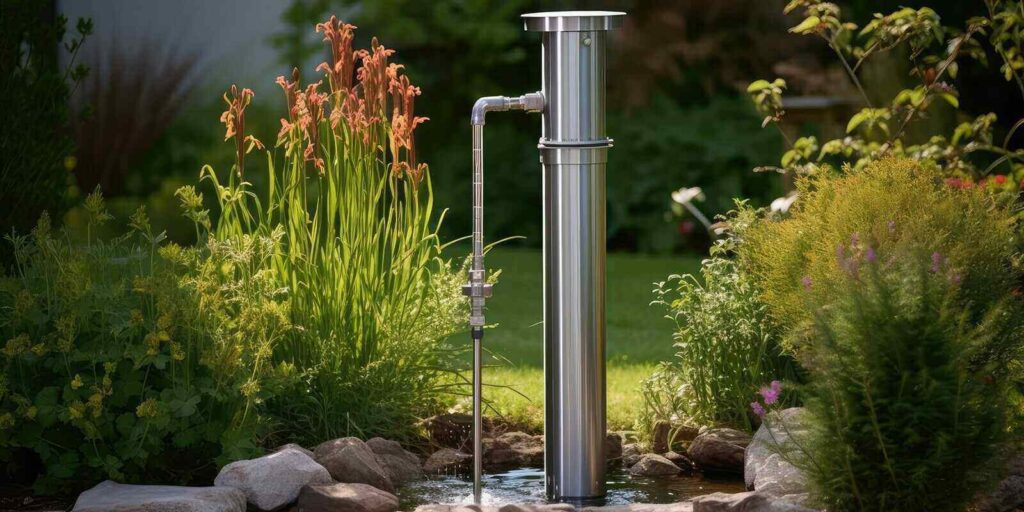
Having the knowledge of how this pump works will help you make informed decisions about maintenance, efficiency, and long-term performance.
What a Submersible Well Pump Does Underground
A submersible well pump is a major component of your private well system that’s designed to push water from beneath the ground into your home, operating completely underwater. Unlike above-ground systems that pull water upward, submersible pumps are built to operate from within the well itself.
Since the pump operates below the water’s surface, it doesn’t need to be primed and rarely suffers from cavitation problems. Cavitation, a damaging condition caused by vapor bubbles in water, is far more common in pumps that operate above ground due to pressure fluctuations.
The pump housing usually has a slim, vertical profile that stretches several feet down into the well. Inside, a sealed electric motor is welded into a watertight casing filled with dielectric fluid. Its hermetic seal protects the motor from moisture and debris while allowing it to operate in submerged conditions for extended periods.
The motor and shaft work in tandem, turning a series of blades to push water upward. Each impeller adds velocity to the water, while accompanying diffusers convert that velocity into pressure. The number of impeller-diffuser stages depends on the depth and pressure requirements of the well system.
A mesh barrier at the intake blocks coarse debris and shields internal mechanisms. Just above that, a check valve keeps pressurized water from flowing backward into the well when the pump shuts off, which prevents reverse spin and helps avoid water hammer in the plumbing.
Additional mechanical supports like thrust bearings and couplings manage axial load and torque from the spinning shaft. Outside the pump, a torque arrestor keeps the unit centered in the well casing, while a safety rope allows for retrieval during servicing.
How the System Operates from Demand to Delivery

Once it falls to the cut-in point, often around 40 psi, a pressure switch located near the tank closes and activates the pump. Power travels through a waterproof cable down to the submerged motor, which spins at approximately 3,000 rpm.
Water enters through the intake screen, and each impeller in the pump adds lift to the water, passing it through a diffuser that builds pressure. The multi-stage configuration means water gains a cumulative increase in pressure as it rises.
The total lift capacity, also known as the total dynamic head, includes the static lift (vertical rise from the water level to the tank) and friction loss from the plumbing. Once water reaches the surface, it travels through a drop pipe into the pressure tank.
As the tank fills, the pressure increases until it hits the switch’s cut-out point, commonly set around 60 psi. At this point, the switch turns off the pump, then the built-in check valve snaps closed to keep water in place and prevent the system from depressurizing.
Between cycles, the pressure tank provides stored water for immediate use, reducing the number of pump starts and prolonging system life.
System Sizing and Setup Details Matter
The pump size and system layout are carefully matched to a home’s water needs and current well capacity. A common setup for a three-bedroom house targets a flow rate of around 10 gallons per minute.
Accurate measurements of the static water depth, pumping water level, vertical lift, and horizontal pipe run help determine the necessary pump head. Tables are used to calculate friction loss in the pipes. Oversizing a pump relative to the well’s output can lead to issues unless a storage system is integrated to buffer demand.
Submersible pumps typically come in two wiring types: two-wire and three-wire. Two-wire motors contain all starting components sealed inside the motor housing, which simplifies installation.
Unfortunately, a malfunctioning component often requires pulling the entire assembly from underground. Three-wire setups use a control box at the surface with start capacitors and relays, making it easier to service electrical components without disturbing the submerged unit.
Proper placement of the pump is also important; it should be positioned several feet above the bottom of the well to avoid pulling in sediment. Sand and silt can wear down the impeller stack and reduce performance over time, highlighting the importance of placement.
In low-flow wells, a flow sleeve may be added to direct water past the motor to cool the system down. Manufacturers stress the importance of adequate flow to prevent overheating, which can rapidly damage the motor.
Reliable Water Starts with the Right Pump

Our technicians are trained in-house and understand the entire water system of your home, from the bottom of the well to your faucet. We take time to educate our customers with straightforward information so you can make confident decisions about your water supply.
If you’re experiencing changes in water pressure, pump cycling problems, or just want assurance about your current setup, we’re ready to help. Contact us or call at 1-(301)-432-0330 to get started today.


